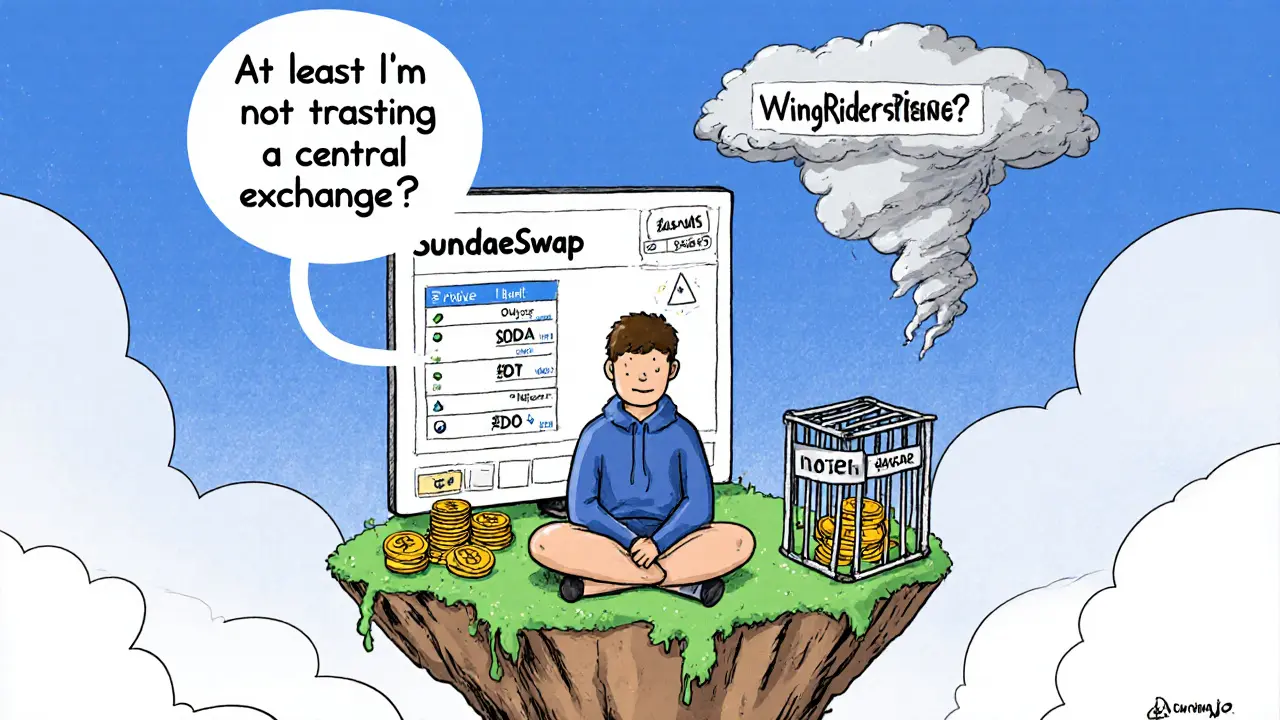SundaeSwap Fee Calculator
Calculate Your Swap Costs
Your Total Costs
Comparison to Centralized Exchanges
When you want to trade Cardano tokens without handing your keys to a centralized exchange, SundaeSwap is the only real option on the network. But after years of hype, the platform still feels like a work in progress. If you’re wondering whether SundaeSwap v3 is worth your time in late 2025, the answer isn’t simple. It’s not the most powerful DEX out there. It’s not the fastest. And it doesn’t have the liquidity of Uniswap or PancakeSwap. But if you’re deep into the Cardano ecosystem, it might be the only tool that actually works.
What SundaeSwap v3 Actually Does
SundaeSwap is a decentralized exchange built exclusively for Cardano. That means you can’t trade Bitcoin, Ethereum, or Solana tokens here. You trade ADA, and tokens issued on Cardano - things like $MILK, $HOT, $SHIBA, or any native token built using Cardano’s token standard. There are no order books. No limit orders. No margin trading. Just swaps. You pick two tokens, click ‘Swap’, and the protocol handles the rest using liquidity pools.
Unlike centralized exchanges where your funds sit in their wallets, SundaeSwap is non-custodial. Your ADA and tokens stay in your wallet - Nami, Yoroi, Flint, or ccVault. The swap happens directly between your wallet and a smart contract on Cardano. That’s the whole point of a DEX: you’re in control. No KYC. No withdrawals to wait for. No account freezes.
As of November 2025, SundaeSwap has around $7.1 million locked in liquidity. That’s up from $4.2 million earlier this year thanks to a new incentive program for liquidity providers. It’s not much compared to Ethereum-based DEXs, but it’s still the largest on Cardano by far. KaiDex and MistSwap are smaller. WingRiders is growing fast, but hasn’t passed it yet.
The Fee Structure Is Confusing - And Expensive
One of the biggest complaints about SundaeSwap isn’t that it’s slow - it’s that the fees are messy. The platform uses a tiered fee system that ranges from 0.1% to 1% per trade. The lower fee tiers are locked behind staking SUNDAE tokens. To get the 0.1% rate, you need to stake at least 50,000 SUNDAE. Most users are stuck at the 0.3% or 0.5% tier. For small swaps under $50, that’s a big chunk of your money.
Compare that to centralized exchanges like Binance or KuCoin, where trading fees are often 0.1% or less - and sometimes free with volume. On SundaeSwap, even a $100 swap can cost you 30-50 cents in fees. That’s not just inconvenient. It’s a deterrent for casual users.
And here’s the kicker: you still need ADA to pay for Cardano’s network transaction fees. So you’re paying twice - once to the DEX, once to the blockchain. That’s not unique to SundaeSwap, but it’s still a pain point.
Performance: Slow, But Reliable
Cardano’s blockchain settles blocks every 20 seconds. That means trades on SundaeSwap usually confirm in under a minute. But during high traffic - like when a new token launches or ADA surges - things get messy. Users report failed transactions, stuck swaps, and wallet disconnections. According to internal metrics from SundaeSwap Labs, about 32% of trades during peak hours fail on the first attempt.
That’s not because the code is broken. It’s because Cardano’s throughput caps out at around 250 transactions per second. When 10,000 people try to swap at once, the network backs up. There’s no way around it. Ethereum DEXs handle thousands of swaps per second. Cardano can’t. So if you need speed, SundaeSwap isn’t your tool.
But if you’re patient, it works. Once your transaction clears, it’s final. No reorgs. No chain splits. Cardano’s proof-of-stake consensus is solid. There have been zero major exploits on SundaeSwap since its 2022 launch. That’s more than you can say for some bigger DEXs.

Who Uses SundaeSwap? (And Why)
The typical SundaeSwap user isn’t a day trader. They’re a Cardano holder who believes in the ecosystem. CoinGecko’s 2025 survey found that 78% of users only hold Cardano-based tokens. They’re not looking to flip Bitcoin. They’re trying to move from ADA to $MILK, or from $SHIBA to $HOT. They want to stay inside Cardano’s world.
That’s why SundaeSwap still matters. Without it, Cardano tokens would have no way to trade without going to centralized exchanges. And once you send ADA to Binance or Coinbase, you lose the benefits of decentralization. You’re trusting someone else with your assets.
Reddit users in r/cardano say it best: “Finally able to swap my Cardano tokens without leaving the ecosystem.” That’s the core value. It’s not about being the best. It’s about being the only one that lets you do this without compromise.
What’s Missing? (And Why It Matters)
SundaeSwap v3 doesn’t have limit orders. No stop-losses. No trading pairs with stablecoins like USDT or USDC. No cross-chain bridges. No lending. No yield farming. It’s just a swap tool.
That’s fine if you only want to exchange one Cardano token for another. But if you want to do anything more advanced - like setting a price alert to buy $MILK at $0.002 - you’re out of luck. You’ll have to check prices manually, then come back and swap when you see the right number. That’s not trading. That’s manual monitoring.
WingRiders and KaiDex are starting to add some of these features. If SundaeSwap doesn’t catch up, it risks becoming a relic. The community wants more. The roadmap promises a governance upgrade in Q4 2025. But promises don’t pay bills. Users are watching.

How to Get Started (Step by Step)
If you’re ready to try it, here’s how:
- Install a Cardano wallet: Nami Wallet (easiest for beginners), Yoroi, Flint, or ccVault.
- Buy ADA on a centralized exchange (like Binance or Kraken) and send it to your wallet.
- Go to sundaeswap.finance and click ‘Connect Wallet’.
- Select your wallet from the list. Confirm the connection in your wallet app.
- Pick the tokens you want to swap. Type in the amount. Click ‘Swap’.
- Confirm the transaction in your wallet. Pay the network fee in ADA.
- Wait 10-60 seconds. Your tokens arrive.
First-timers take about 22 minutes to get through this if they’ve used crypto before. If you’re new to wallets and blockchains, it can take over an hour. There are no guided walkthroughs. No tooltips. You’re on your own.
Is SundaeSwap v3 Worth It in 2025?
Here’s the truth: SundaeSwap isn’t for everyone. If you’re trading large amounts, want advanced tools, or need speed - look elsewhere. Use a centralized exchange. It’s faster, cheaper, and easier.
But if you’re a Cardano believer who wants to keep full control of your assets, and you only trade native Cardano tokens? SundaeSwap is still the only real option. It’s not perfect. It’s not flashy. But it works. And for now, that’s enough.
The real question isn’t whether SundaeSwap is good. It’s whether Cardano’s ecosystem can grow fast enough to support a better DEX. If WingRiders or another project launches with limit orders, stablecoin pairs, and lower fees - SundaeSwap could fade fast. But if Cardano’s user base keeps growing, and no one else steps up? SundaeSwap will stay the default - flaws and all.
Is SundaeSwap v3 the only DEX on Cardano?
No, but it’s the largest. Other DEXs like WingRiders, KaiDex, and MistSwap are active, but none have reached SundaeSwap’s $7 million+ TVL. WingRiders is growing quickly and may overtake it soon, especially if it adds advanced trading features.
Can I trade Bitcoin or Ethereum on SundaeSwap?
No. SundaeSwap only supports native Cardano tokens. You can’t swap BTC, ETH, SOL, or any non-Cardano asset. If you want to trade those, you need a centralized exchange or a cross-chain bridge - neither of which SundaeSwap supports.
What wallets work with SundaeSwap v3?
You need a Cardano-compatible wallet: Nami Wallet, Yoroi, Flint Wallet, or ccVault. MetaMask and Trust Wallet won’t work because they’re for Ethereum and BNB Chain. Nami is the most user-friendly for beginners.
Are SundaeSwap fees high compared to other DEXs?
Yes, especially for small trades. SundaeSwap’s fees range from 0.1% to 1%, and most users pay 0.3-0.5% because they don’t stake enough SUNDAE tokens. Add Cardano’s network fee (usually 0.17 ADA), and you’re paying more than on centralized exchanges. For swaps under $50, the fees can eat up 10% or more of your trade.
Does SundaeSwap have limit orders or stop-losses?
No. As of November 2025, SundaeSwap only supports instant swaps. There are no limit orders, no market orders beyond the current price, and no stop-losses. If you want to buy at a specific price, you have to monitor the market manually and swap when it hits.
Is SundaeSwap safe to use?
Yes, as long as you use a trusted wallet and never share your seed phrase. SundaeSwap is non-custodial, meaning your funds never leave your wallet. There have been no major hacks or exploits since its 2022 launch. The biggest risk is user error - sending the wrong token, approving a bad contract, or losing your wallet password.
What’s the future of SundaeSwap?
SundaeSwap Labs plans a governance upgrade in Q4 2025 to let SUNDAE holders vote on protocol changes. They’ve also hinted at future features like limit orders and cross-chain bridges. But there’s no official timeline. If they don’t deliver, competitors like WingRiders could take over. Cardano’s ecosystem needs a better DEX - and if SundaeSwap doesn’t evolve, someone else will.
